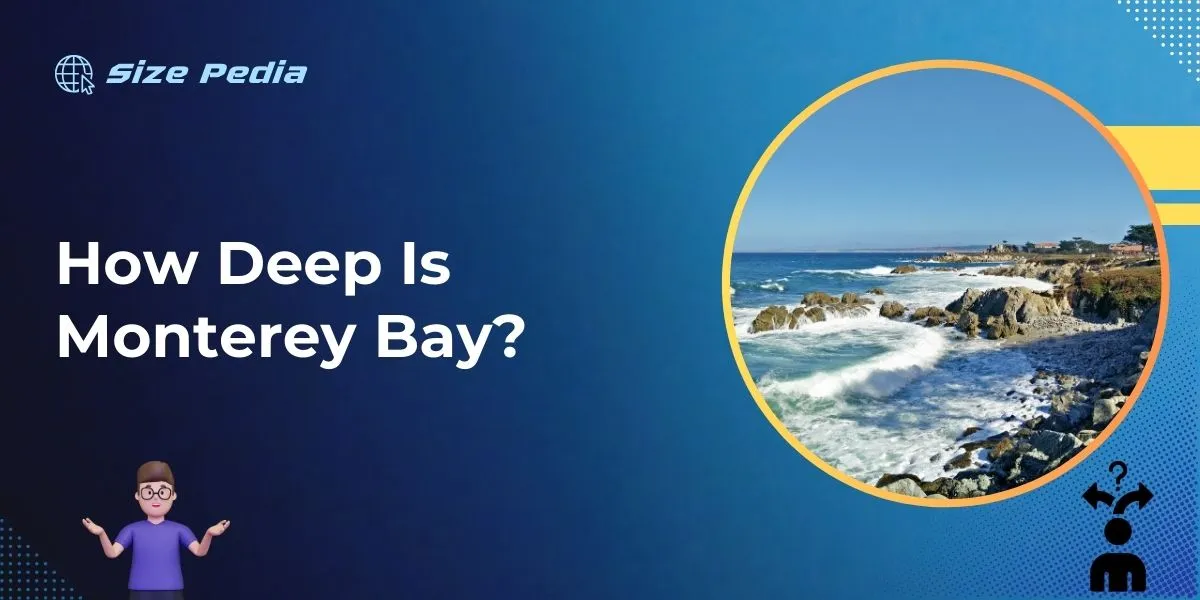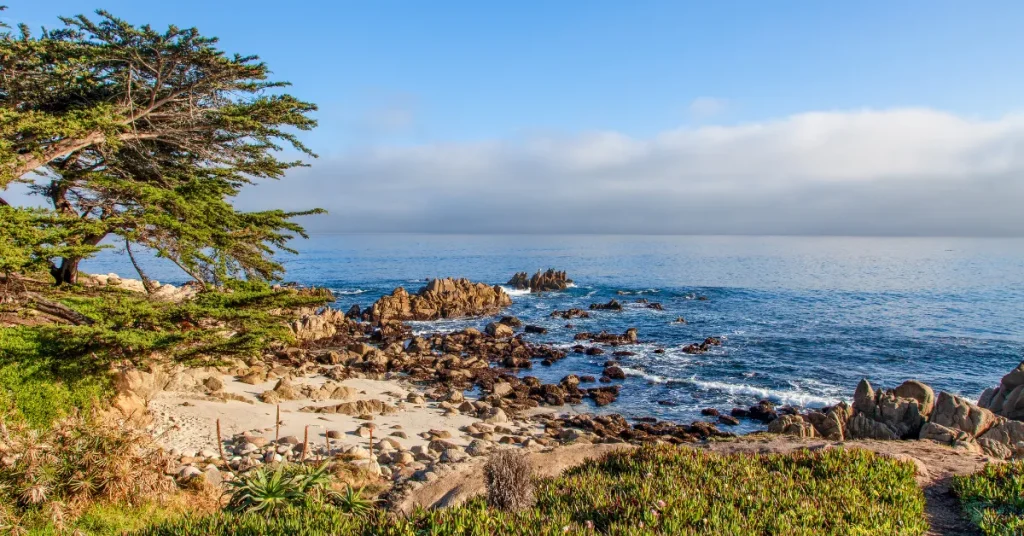Monterey Bay has a maximum depth of about 600 feet (183 meters). The bay is located along the central coast of California.
Monterey Bay is renowned for its significant marine biodiversity and is part of the larger Monterey Bay National Marine Sanctuary. This submarine canyon, which is akin to the Grand Canyon due to its size, offers a unique environment for an array of aquatic life.
The bay’s depth and nutrient-rich waters are key reasons for its diverse ecosystem, which attracts both tourists and researchers.
Many come to experience its vibrant marine habitats, explore its depths through scuba diving, and participate in whale watching ventures, as the bay serves as a feeding ground for multiple whale species.
The depth of Monterey Bay is just one of its many wonders, making it a fascinating subject for marine studies and a popular destination for ocean enthusiasts.

The Mystique Of Monterey Bay
The Mystique of Monterey Bay calls to explorers and nature lovers alike. Its depths hold stories from ages past and present. Here, the Pacific whispers ancient tales while bestowing awe-inspiring vistas.
A Natural Wonder
Monterey Bay’s vastness is awe-inspiring. Its deep waters offer a sanctuary for diverse marine life. This underwater marvel unveils a grand expanse below the surface.
The bay plunges to over two miles deep at its core, known as the Monterey Submarine Canyon. Comparable to the grandeur of the Grand Canyon, this feature remains mostly a mystery, hiding extraordinary creatures and geological wonders.
- Rich biodiversity: Home to seals, otters, and whales.
- Dramatic topography: From shallow kelp forests to deep-sea canyons.
- Protected habitat: National Marine Sanctuaries safeguard its uniqueness.
Historical Significance
The waters off Monterey Bay whisper with historical echoes. This bay’s past is as deep and vast as the canyon itself. Once a hub of the sardine-packing industry, its story is immortalized in literature and local lore.
John Steinbeck’s “Cannery Row” captures the vibrancy of the bay’s bustling past. Today, preserved sites and monuments pay tribute to the rich history woven into its coastal tapestry.
| Historic Landmarks | Significance |
| Cannery Row | Literary landmark, former sardine canning hub |
| Monterey Bay Aquarium | Conservation leader, educates about marine life |
| Old Fisherman’s Wharf | Historic fishing pier, local culture showcase |
Measuring The Depths
Exploring the mysteries of the ocean begins with a crucial task: measuring its depths. Monterey Bay’s waters conceal a fascinating submarine canyon rivaling the majesty of the Grand Canyon. But how deep is this aquatic chasm?
Answering this question isn’t just a matter of satisfying curiosity; it has significant implications for marine science, ecology, and even coastal safety.
To unlock the secrets of Monterey Bay’s depths, scientists and researchers employ advanced methods. The depth of this marine spectacle varies across its expanse, plunging into profound darkness at its deepest points.
Tools For Oceanography
Dedicated tools are vital in plumbing the depths of Monterey Bay. Let’s explore the instruments that help paint a picture of the underwater terrain:
- Echo Sounders – Bounce sound waves off the seafloor, revealing its contours.
- Submersible Vehicles – Navigate the dark waters to map and capture visuals.
- Drop Cameras – Provide a glimpse into the abyss with high-resolution images.
- Satellites – Use radar altimetry to approximate sea-floor topography from space.
Challenges In Deep Sea Measurement
Despite these tools, measuring the depths of Monterey Bay is no small feat. Researchers face several challenges in the deep sea:
| Challenge | Impact on Measurement |
| Water Pressure | Limits the depth to which equipment can be deployed. |
| Light Penetration | Necessitates artificial lighting for visual data collection. |
| Underwater Terrain | Hinders the movement of submersible vehicles over rugged landscapes. |
| Data Transmission | Requires sophisticated technology to relay information to the surface. |
In conclusion, mapping the true depths of Monterey Bay depends on these tools and overcoming the inherent challenges of deep-sea exploration.
As advancements in technology continue, our understanding of Monterey Bay’s depths will only grow more precise.
Monterey Bay’s Unique Bathymetry

Monterey Bay boasts a seascape as rich and varied as its marine inhabitants. This exceptional undersea terrain, known as ‘bathymetry’, shapes the conditions and livelihoods of marine creatures below the waves.
The Underwater Canyon
Like a submerged Grand Canyon, the Monterey Submarine Canyon cuts through the bay. It plunges to over two miles below the surface, making it one of the deepest underwater canyons along the continental United States.
Its vast depths are accessible surprisingly close to shore, offering a unique oceanscape for research and exploration.
Marine Life And Depth Correlation
Monterey Bay’s depths create different habitats at various levels. Each zone supports distinct species forming a complex ecosystem. Let’s dive deeper:
- The sunlit upper layers foster kelp forests. These shelter sea otters, fishes and invertebrates.
- Moving down, the twilight zone supports squid and deep-sea fishes, adapted to limited light.
- On the canyon floor, life defies darkness. Here, animals have unique adaptations to survive extreme pressure and cold.
Diverse depth zones offer remarkable biodiversity, making Monterey Bay a hotspot for scientists and wildlife enthusiasts alike.
The Deepest Points
Ever wondered how deep the ocean can get? Right in Monterey Bay, nature’s secrets are submerged beneath the waves. Let’s dive into the bay’s deepest parts, revealing hidden wonders and exploring the undersea terrain.
Monterey Submarine Canyon
Monterey Bay is home to a marine marvel: the Monterey Submarine Canyon. This underwater chasm rivals the Grand Canyon in scale and splendor. It begins at Moss Landing, precisely in the heart of the bay, and extends for miles beneath the Pacific.
- Depth: Over two miles deep at certain points
- Length: Stretches 95 miles into the ocean
- Width: Reaches up to one mile across
Comparisons With Other Oceanic Depths
Monterey’s underwater canyon holds its own against other deep-sea titans. Its stark depth creates a unique habitat for diverse marine life, from sea otters to mysterious squid.
| Location | Depth |
| Monterey Submarine Canyon | More than 12,000 feet |
| Mariana Trench | Up to 36,070 feet |
| Puerto Rico Trench | Over 27,480 feet |
The ocean’s depths reveal a world of wonders, with Monterey Bay offering a portal to this submerged universe. It’s a unique deep-sea habitat, accessible and awe-inspiring.
Human Exploration Of Monterey Bay

Monterey Bay is not just a beautiful coastal treasure. It is a site of deep-sea wonder and human curiosity. The Bay’s depths have lured explorers and scientists to uncover its mysteries.
Such exploration has expanded our knowledge about life below the surface. Let’s dive into the human journey beneath these waves.
Submersible Dive Missions
Deep-sea submersibles have long been key in exploring Monterey Bay. Researchers pilot these vessels into the bay’s depths. They face darkness and pressure that would crush most sea life.
These missions provide a look into an otherwise inaccessible world. Submersibles like the famous Alvin have descended into the depths. They allow scientists to observe, collect, and analyze samples right from the sea floor.
- Deep Ocean Adventure: Historically, submersible dives have shown us landscapes far below. They’ve discovered towering underwater mountains.
- Marine Life Galore: These missions have encountered unique creatures. Some never seen before by human eyes.
- Technological Marvels: Each dive advances submersible technology. This technology gives us better views of the deep.
Scientific Discoveries Below
Each trip below the surface reveals new scientific insights. Researchers studying Monterey Bay have made fascinating findings. These dives peel back layers of the ocean’s secrets.
| Year | Discovery | Significance |
| 1997 | New Octopus Species | Showcased biodiversity in the bay. |
| 2002 | Deep-sea Coral Gardens | Revealed ancient living structures. |
| 2011 | Microbial Life in Rocks | Expanded understanding of life in extreme conditions. |
These discoveries have vast implications. They affect our knowledge of marine biology. They also influence how we protect these delicate ecosystems. Scientists continue to explore, eager for the next surprising find.
Conservation Efforts
Monterey Bay, a marine wonder, hides secrets in its deep waters. Beyond its beauty lies a dedication to its protection.
Important work happens daily to ensure this oceanic treasure lasts for generations. Let’s dive into the conservation efforts safeguarding the depths of Monterey Bay.
Protecting The Depths
The bay’s health relies on mindful stewardship. Bold efforts include:
- Restrictions on fishing to sustain fish populations
- Pollution control measures to keep waters clean
- Habitat restoration projects to bring back natural balance
- Public education to promote environmental awareness
The Role Of The Monterey Bay National Marine Sanctuary
The Monterey Bay National Marine Sanctuary stands as a guardian of the deep. It oversees:
| Activity | Impact |
| Research Programs | Gather crucial data on marine life and ecosystems |
| Conservation Policies | Implement rules to protect marine species and habitats |
| Community Engagement | Involve locals in safeguarding their marine backyard |
| Educational Outreach | Teach future generations about marine conservation |
FAQs About How Deep Is Monterey Bay
What Is The Depth Of Monterey Bay?
Monterey Bay’s maximum depth is about 600 feet (183 meters) along its submarine canyon. This makes it one of the deepest coastal waters in North America.
Can You Swim In Monterey Bay?
Yes, you can swim in Monterey Bay, but the water is usually quite cold. Swimmers and surfers often wear wetsuits to retain warmth while enjoying the bay.
Are There Sharks In Monterey Bay?
Monterey Bay is home to various shark species, including Great Whites. While encounters are rare, it’s wise to stay informed about local wildlife advisories.
What Marine Life Inhabits Monterey Bay?
Monterey Bay is a biodiversity hotspot. It houses marine mammals like sea otters, seals, and whales. Its waters are also rich with various fish and invertebrates.
Conclusion
Diving into the depths of Monterey Bay reveals a mesmerizing underwater world. With its 600-foot canyon base, it’s a marvel for marine scientists and enthusiasts alike.
Exploring this aquatic wonder offers insights into the bay’s rich biodiversity. Remember, this marine haven runs deep, both literally and in its ecological significance.
Resources:
1. https://montereybay.noaa.gov/visitor/explore.html
